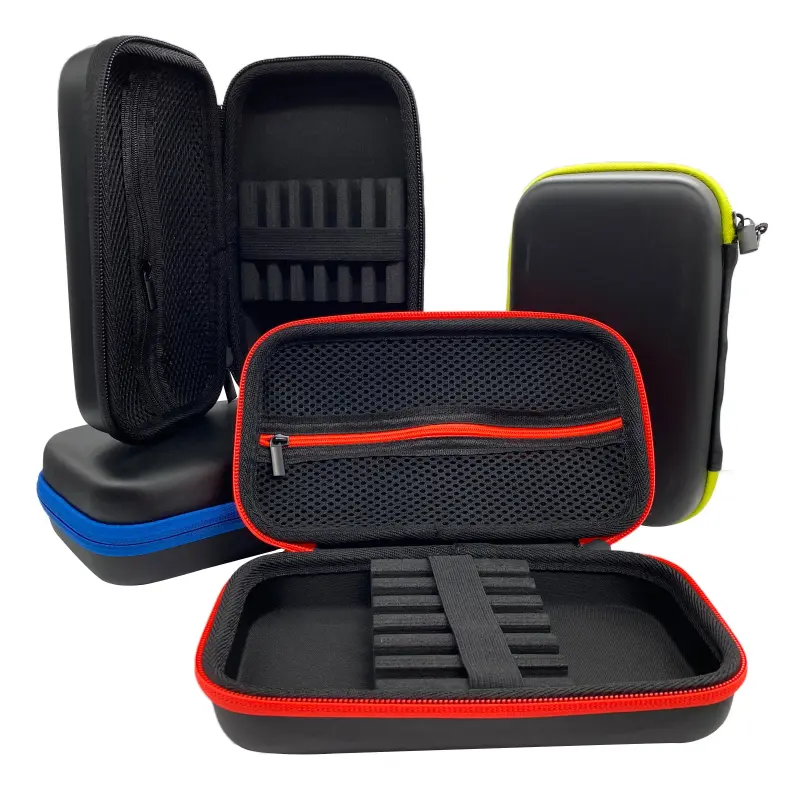I. First, clarify: The industry attributes of downstream customers determine core size requirements.
Different industries have significantly different size requirements for EVA tool kits. Before wholesale purchasing, it is necessary to identify the application scenarios of the target customers to avoid “one-size-fits-all” purchasing. The following are size references for five major industries:
1. Electronics/Precision Instruments Industry (Most Common)
Application Scenario: Storage of small precision tools such as circuit boards, screwdrivers, multimeters, and connectors.
Core Requirements: Compact and space-saving, clearly defined tool compartments, easy to carry to the workstation.
Recommended Size Range:
External: 20cm×15cm×5cm ~ 30cm×20cm×8cm
Internal Dividers: 1-2cm buffer space should be reserved (to prevent tool wear and tear)
Purchasing Reminder: If the customer needs to install a laptop (e.g., for on-site debugging), an additional 13-15 inch model is required (external dimensions approximately 35cm×25cm×10cm).
2. Machinery/Auto Repair Industry
Application Scenarios: Storage of medium-sized tools such as wrenches, pliers, socket wrenches, and torque wrenches.
Core Requirements: Sufficient capacity, wear-resistant and drop-resistant, portable (hand-carry or shoulder-carry).
Recommended Size Range:
External: 40cm×30cm×15cm ~ 50cm×35cm×20cm
Internal Compartments: Requires a 10-15cm deep tool slot (suitable for long-handled tools).
Purchase Note: Some auto repair customers require a “layered design,” which can be selected as a two-tiered design (total height not exceeding 25cm to avoid excessive weight).
3. Medical/Emergency Industry
Application Scenarios: Storage of emergency medications, stethoscopes, blood pressure monitors, lancets, and other medical supplies.
Core Requirements: Compliance with hygiene standards, size suitable for medical kits/first aid boxes, and easy access to items.
Recommended Size Range:
External: 25cm×18cm×10cm ~ 35cm×25cm×12cm
Internal Compartments: Must distinguish between a “Medicine Area” (shallow compartment, 5cm deep) and an “Instrument Area” (deep compartment, 8-10cm deep).
Purchasing Reminder: Some countries (such as the EU) have compliance requirements for medical kit dimensions; local standards (such as EN 13000 First Aid Kit Size Specification) must be confirmed in advance.
4. Outdoor/Camping Industry
Application Scenarios: Storage of camping tools (such as flashlights, multi-tools, fire starters), small repair tools
Core Requirements: Lightweight, waterproof, and compatible with backpack hooks
Recommended Size Range:
External: 15cm×10cm×4cm ~ 25cm×18cm×6cm
Hook Location: Top or side, allow 2-3cm of space for the hook strap
Purchase Reminder: Avoid oversized items (over 30cm), as this will increase the perceived weight of the backpack.
5. Beauty/Personal Care Tools Industry
Application Scenarios: Storage of beauty tools such as makeup brushes, nail tools, and hair scissors
Core Requirements: Aesthetically pleasing and portable, with delicate internal compartments (to protect tool tips)
Recommended Size Range:
External: 18cm×12cm×6cm ~ 28cm×18cm×8cm
Internal Compartments: Requires narrow grooves (e.g., makeup brush compartment diameter 1-2cm, depth 5-7cm)
Purchasing Reminder: If the client primarily targets “travel style,” the size should be controlled within 20cm×15cm (to fit the side pocket of a suitcase).
II. Further Considerations:3 Key Size Factors
Besides downstream customer demand, buyers also need to consider the following three points from the perspectives of “cost control” and “market fit”:
1. External Dimensions vs. Logistics Costs: Avoiding “Ineffective Oversized Packages”
Air Freight/Express: International logistics (such as DHL, FedEx) have strict restrictions on package dimensions. Packages with a combined length, width, and height exceeding 100cm will incur an “oversized item fee.” It is recommended to prioritize dimensions with a combined length, width, and height of ≤80cm (e.g., 40cm×30cm×10cm) to reduce unit transportation costs. 1. Ocean Freight/Container Shipping: Stacking efficiency needs to be calculated. For example, a standard 20-foot container (internal dimensions 5.9m × 2.35m × 2.39m) can stack 19 × 11 × 23 = 4787 tools if the tool kit’s external dimensions are 30cm × 20cm × 10cm. However, if the dimensions are irregular (e.g., 35cm × 25cm × 15cm), only 16 × 9 × 15 = 2160 tools can be stacked, significantly reducing inventory utilization.
2. Internal Dimensions vs. Tool Fit: Avoiding Wasteful Space. Actual tool dimensions: Before purchasing, downstream customers should provide a “tool list + maximum dimensions” (e.g., longest tool 18cm, widest tool 10cm). Internal compartment dimensions should be 1-2cm larger than the maximum tool dimensions (to allow for removal space), but not too large (otherwise, tool movement will cause wear). Example: If the maximum length of a customer’s tool is 20cm, the internal compartment length can be designed to be 21cm; there’s no need to design it to be 25cm (to avoid wasting materials and space, and increasing costs).
3. General Sizes vs. Custom Sizes: Balancing “Inventory and Flexibility”
General Sizes: It is recommended to keep 3-5 “industry-standard sizes” in stock (e.g., 25cm×18cm×7cm for the electronics industry, 45cm×32cm×18cm for the auto repair industry) to meet the needs of most customers and reduce the risk of inventory backlog.
Custom Sizes: If downstream customers have bulk customization needs (e.g., their own brand logo + special sizes), the “minimum order quantity” and “mold cost” need to be confirmed (EVA molds are mostly customized; size adjustments require new molds, so a minimum order quantity of ≥500 pieces is usually more cost-effective).
III. Practical Steps: 3 Steps to Determine the Optimal Size
Step 1: Collect Customer Needs and List “Core Parameters”
Have downstream customers fill out the “Tool List,” including:
① Tool Name and Quantity
② Maximum Length, Width, and Height of the Tool
③ Usage Scenarios (Portable/Fixed Storage)
④ Whether it needs to be compatible with other containers (such as suitcases, toolboxes)
Example: An electronics customer’s needs are “10 screwdrivers (maximum 15cm) + 1 multimeter (20cm×10cm×5cm) + portable to the workstation.” The core parameter is “maximum tool size 20cm×10cm×5cm, portability required.” Step 2: Select “Candidate Sizes” Based on Logistics Costs
Based on the customer’s core parameters, initially select 2-3 suitable sizes, then calculate the “unit logistics cost”:
For example: Candidate size A (25cm×18cm×8cm, stackable 4787 pieces/20-foot cabinet), Candidate size B (30cm×22cm×10cm, stackable 39×10×23=8970 pieces/20-foot cabinet). If the customer’s demand is large, size B has lower logistics costs and is more suitable for bulk purchasing. Step 3: Test Samples to Confirm “Actual Compatibility” Request samples from the supplier for actual testing by the customer: ① Can all tools be placed inside, and is it easy to take them out? ② Does it fit the user’s habits when carrying it (e.g., is it comfortable to carry by hand, or too heavy to carry on the shoulder)? ③ Is it stable when stacked (to prevent tipping during transportation)?
Note: If the customer is a “global distributor,” the usage habits of different regions need to be considered (e.g., European and American customers prefer shoulder carry, so the size can be slightly larger; Southeast Asian customers prefer hand carry, so the size needs to be more compact).
IV. Our Support: Providing “Size Solutions” for Global Buyers
Size Database: Covers general size parameters for 10+ industries, allowing direct lookup of suitable solutions; Rapid Sample Customization: Supports small-batch (≥50 pieces) sample customization to help you test customer needs; Logistics Optimization Suggestions: Provides optimal size-logistics cost combinations based on your target market (e.g., Europe/America/Southeast Asia/Middle East).
Post time: Nov-03-2025





